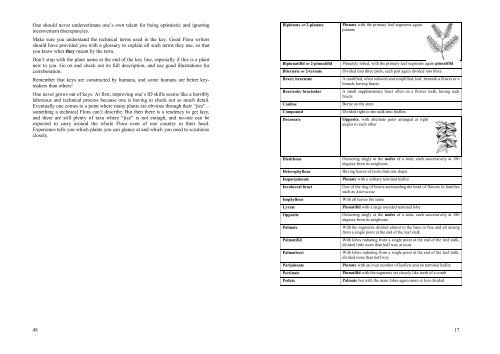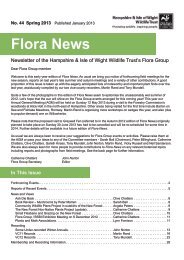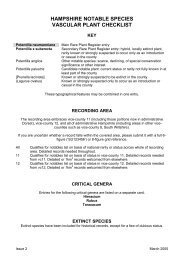An A5 booklet version as distributed in the - Hants Plants
An A5 booklet version as distributed in the - Hants Plants
An A5 booklet version as distributed in the - Hants Plants
Create successful ePaper yourself
Turn your PDF publications into a flip-book with our unique Google optimized e-Paper software.
One should never underestimate one’s own talent for be<strong>in</strong>g optimistic and ignor<strong>in</strong>g<br />
<strong>in</strong>convenient discrepancies.<br />
Make sure you understand <strong>the</strong> technical terms used <strong>in</strong> <strong>the</strong> key. Good Flora writers<br />
should have provided you with a glossary to expla<strong>in</strong> all such terms <strong>the</strong>y use, so that<br />
you know what <strong>the</strong>y meant by <strong>the</strong> term.<br />
Don’t stop with <strong>the</strong> plant name at <strong>the</strong> end of <strong>the</strong> key l<strong>in</strong>e, especially if this is a plant<br />
new to you. Go on and check out its full description, and use good illustrations for<br />
corroboration.<br />
Remember that keys are constructed by humans, and some humans are better keymakers<br />
than o<strong>the</strong>rs!<br />
One never grows out of keys. At first, improv<strong>in</strong>g one’s ID skills seems like a horribly<br />
laborious and technical process because one is hav<strong>in</strong>g to check out so much detail.<br />
Eventually one comes to a po<strong>in</strong>t where many plants are obvious through <strong>the</strong>ir “jizz” –<br />
someth<strong>in</strong>g a technical Flora can’t describe. But <strong>the</strong>n <strong>the</strong>re is a tendency to get lazy,<br />
and <strong>the</strong>re are still plenty of taxa where “jizz” is not enough, and no-one can be<br />
expected to carry around <strong>the</strong> whole Flora even of one country <strong>in</strong> <strong>the</strong>ir head.<br />
Experience tells you which plants you can glance at and which you need to scrut<strong>in</strong>ize<br />
closely.<br />
48<br />
Bip<strong>in</strong>nate or 2-p<strong>in</strong>nate P<strong>in</strong>nate with <strong>the</strong> primary leaf segments aga<strong>in</strong><br />
p<strong>in</strong>nate<br />
Bip<strong>in</strong>natifid or 2-p<strong>in</strong>natifid P<strong>in</strong>nately lobed, with <strong>the</strong> primary leaf segments aga<strong>in</strong> p<strong>in</strong>natifid<br />
Biternate or 2-ternate Divided <strong>in</strong>to three parts, each part aga<strong>in</strong> divided <strong>in</strong>to three<br />
Bract; bracteate A modified, often reduced and simplified, leaf, beneath a flower or a<br />
branch; hav<strong>in</strong>g bracts<br />
Bracteole; bracteolar A small supplementary bract often on a flower stalk; hav<strong>in</strong>g such<br />
bracts<br />
Caul<strong>in</strong>e Borne on <strong>the</strong> stem<br />
Compound Divided right to <strong>the</strong> stalk <strong>in</strong>to leaflets<br />
Decussate Opposite, with alternate pairs arranged at right<br />
angles to each o<strong>the</strong>r<br />
Distichous Occurr<strong>in</strong>g s<strong>in</strong>gly at <strong>the</strong> nodes of a stem, each successively at 180<br />
degrees from its neigbours<br />
Heterophyllous Hav<strong>in</strong>g leaves of more than one shape<br />
Imparip<strong>in</strong>nate P<strong>in</strong>nate with a solitary term<strong>in</strong>al leaflet<br />
Involucral bract One of <strong>the</strong> r<strong>in</strong>g of bracts surround<strong>in</strong>g <strong>the</strong> head of flowers <strong>in</strong> families<br />
such <strong>as</strong> Asteraceae<br />
Isophyllous With all leaves <strong>the</strong> same<br />
Lyrate P<strong>in</strong>natifid with a large rounded term<strong>in</strong>al lobe<br />
Opposite Occurr<strong>in</strong>g s<strong>in</strong>gly at <strong>the</strong> nodes of a stem, each successively at 180<br />
degrees from its neigbours<br />
Palmate With <strong>the</strong> segments divided almost to <strong>the</strong> b<strong>as</strong>e or free and all aris<strong>in</strong>g<br />
from a s<strong>in</strong>gle po<strong>in</strong>t at <strong>the</strong> end of <strong>the</strong> leaf stalk<br />
Palmatifid With lobes radiat<strong>in</strong>g from a s<strong>in</strong>gle po<strong>in</strong>t at <strong>the</strong> end of <strong>the</strong> leaf stalk,<br />
divided little more than half way at most<br />
Palmatisect With lobes radiat<strong>in</strong>g from a s<strong>in</strong>gle po<strong>in</strong>t at <strong>the</strong> end of <strong>the</strong> leaf stalk,<br />
divided more than half way<br />
Parip<strong>in</strong>nate P<strong>in</strong>nate with an even number of leaflets and no term<strong>in</strong>al leaflet<br />
Pect<strong>in</strong>ate P<strong>in</strong>natifid with <strong>the</strong> segments set closely like teeth of a comb<br />
Pedate Palmate but with <strong>the</strong> ma<strong>in</strong> lobes aga<strong>in</strong> more or less divided<br />
17







